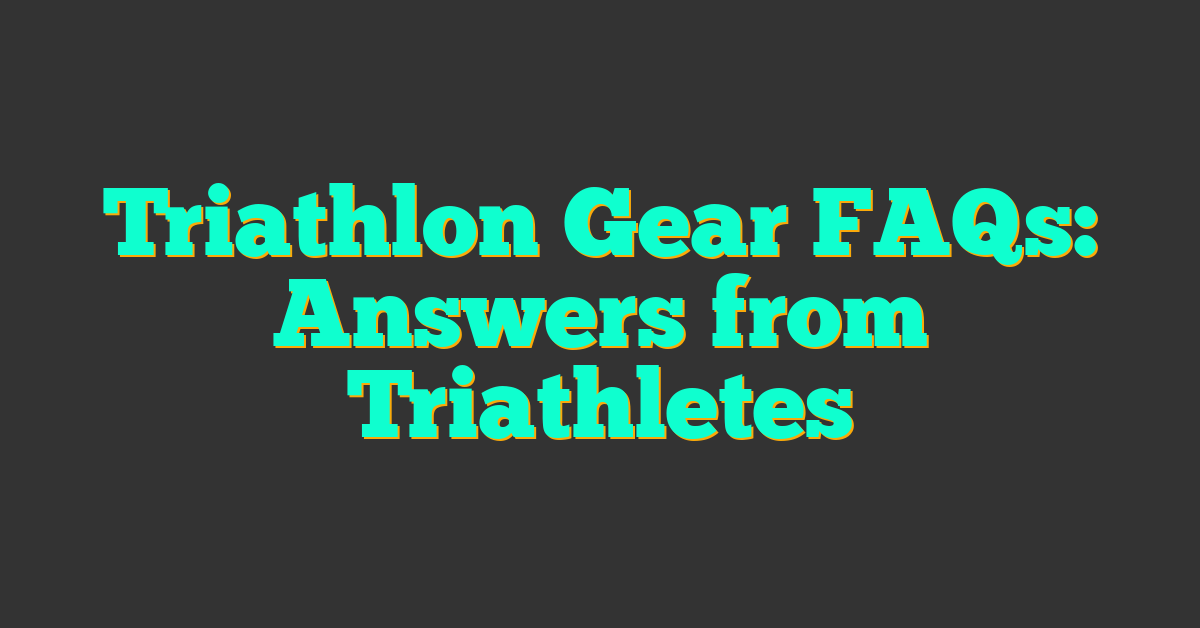If you’re new to triathlons, it can be overwhelming to figure out what gear you need. But don’t worry, we’ve got you covered. In this article, we’ll answer some of the most frequently asked questions about triathlon gear, straight from experienced triathletes. Whether you’re a beginner or a seasoned athlete, you’ll find helpful tips and advice to make sure you’re ready for your next race.

Getting Started with Triathlon Gear
Before you start thinking about specific gear, it’s important to make sure you have the basics covered. This includes comfortable athletic clothing, a good pair of running shoes, and a bike that fits you well. Once you have these essentials, you can start thinking about more specialized triathlon gear.
Mastering the Swim
The swim can be the most intimidating part of a triathlon, especially if you’re not a strong swimmer. But with the right gear and some practice, you can feel confident and comfortable in the water. We’ll cover everything from wetsuits to goggles to help you make the most of your swim.
Key Takeaways
- Make sure you have the basics covered before investing in specialized triathlon gear.
- A wetsuit and goggles can make a big difference in your swim performance.
- Practice makes perfect when it comes to mastering the swim leg of a triathlon.
Getting Started with Triathlon Gear
https://www.youtube.com/watch?v=n3331GKOwZQ&embed=true

If you’re new to triathlon, you might be wondering what gear you need to get started. In this section, we’ll cover the basics of triathlon gear, including the essential gear you’ll need, how to choose the right triathlon suit, and an overview of the different triathlon distances.
Understanding Triathlon Distances
Before you start shopping for gear, it’s important to understand the different triathlon distances. The most common distances are the sprint, Olympic, and Ironman. A sprint triathlon typically involves a 750-meter swim, a 20-kilometer bike ride, and a 5-kilometer run. An Olympic triathlon is twice the distance of a sprint, while an Ironman is a grueling 3.8-kilometer swim, 180-kilometer bike ride, and a 42.2-kilometer run.
Choosing the Right Triathlon Suit
One of the most important pieces of gear for a triathlete is their triathlon suit. A triathlon suit is a one-piece garment that is designed to be worn throughout the race. It’s important to choose a suit that fits well and is comfortable, as you’ll be wearing it for the entire race. Look for a suit that is made from a breathable, moisture-wicking fabric that will keep you cool and dry during the race.
Essential Gear for Beginners
As a beginner, you don’t need to invest in a lot of expensive gear. Here is a list of essential gear you’ll need to get started:
- Swim goggles
- Swim cap
- Wetsuit (if the water is cold)
- Bike
- Helmet
- Cycling shoes (optional)
- Running shoes
- Race belt
Make sure your gear fits properly and is comfortable. You don’t want to be distracted by ill-fitting gear during the race. It’s also a good idea to get fitted for your bike to ensure that it’s the right size and fit for you.
Remember, triathlon is all about having fun and challenging yourself. Don’t worry too much about having the latest and greatest gear. As long as you have the essential gear and a positive attitude, you’re ready to tackle your first triathlon!
Mastering the Swim
https://www.youtube.com/watch?v=Zh9bhXe5lug&embed=true
Swimming is the shortest but most technical leg of a triathlon. It can also be the most challenging for beginners. In this section, we’ll cover everything you need to know to master the swim leg of your triathlon.
Selecting the Perfect Wetsuit
Choosing the right wetsuit is essential for a successful triathlon swim. A wetsuit provides buoyancy and insulation, making you faster and more comfortable in the water. When selecting a wetsuit, consider the water temperature and your budget. A full wetsuit is ideal for colder water, while a sleeveless wetsuit is perfect for warmer water.
Make sure the wetsuit fits snugly but not too tight. You should be able to move your arms and breathe comfortably. Neoprene is the most common material used in wetsuits, but you can also find wetsuits made of other materials like rubber.
Goggles and Swim Caps: A Guide
Goggles and swim caps are essential for every triathlon swim. Goggles protect your eyes from the water and help you see underwater. When selecting goggles, consider the fit, lens color, and lens shape. Latex and silicone are the most common materials used in goggles.
Swim caps keep your hair out of your face and protect your head from the cold water. You can choose between latex and silicone swim caps. Latex swim caps are cheaper, but silicone swim caps are more durable.
Swimming Gear for Improved Performance
There is a wide range of swimming gear available to improve your performance in the water. Earplugs can help prevent water from entering your ears and causing discomfort. Buoyancy shorts can help you maintain proper body position in the water. Paddles and fins can help you build strength and improve your technique.
Remember, the most important thing is to practice your swimming technique regularly. The more you swim, the more comfortable and confident you’ll be in the water.
Cycling Equipment Essentials
https://www.youtube.com/watch?v=euEkwtaT3o4&embed=true
Cycling is a crucial part of any triathlon, and having the right gear can make all the difference in your performance. Here are some essentials to consider when it comes to cycling equipment:
Triathlon Bikes: Speed and Comfort
Choosing the right bike is essential for any triathlete. Triathlon bikes are designed to be fast and aerodynamic, while still being comfortable enough to ride for long periods of time. A triathlon bike is different from a road bike in that it has a more aggressive geometry, which allows for a more aerodynamic position. This position can help you go faster, but it can also be harder on your back and neck. Make sure to test out different bikes and find one that fits your body and riding style.
The Importance of a Proper Bike Fit
One of the most important aspects of cycling is having a proper bike fit. A bike that is not fitted to your body can cause discomfort, pain, and even injury. A good bike fit will take into account your body measurements, flexibility, and riding style. It’s worth investing in a professional bike fit to ensure that you are comfortable and efficient on your bike.
Accessories That Make a Difference
« Get Fit Fast: Great Quick Indoor Workouts for Winter Training
Mistakes Cyclists Make When Storing Bikes for Winter: A Guide to Avoiding Damage and Rust »
There are several accessories that can make a big difference in your cycling performance. Cycling shoes with clipless pedals can help with power transfer and make you more efficient on the bike. A helmet is a must-have for safety, and an aerodynamic helmet can help you go faster. Sunglasses can protect your eyes from the sun and wind, and a bike computer or heart rate monitor can help you track your performance. A power meter can help you train more effectively, and aero bars can help you get into a more aerodynamic position. Don’t forget to bring a multi-tool and tire lever in case of a flat tire.
By investing in quality cycling gear and taking the time to find the right bike fit, you can improve your cycling performance and have a more enjoyable triathlon experience.
Conquering the Run
https://www.youtube.com/watch?v=Tv4Kp-mUn9g&embed=true
Running is the final leg of a triathlon, and it can make or break your race. Here are some tips to help you conquer the run.
Running Shoes: Balancing Comfort and Speed
Your running shoes are arguably the most important piece of gear you’ll need for the run. You want shoes that are comfortable, but also lightweight and fast. Look for shoes with good cushioning and support, but also a low profile to help you run faster.
Make sure you break in your shoes before race day. You don’t want to be dealing with blisters or sore feet during the run. Also, consider getting a gait analysis to determine the best type of shoe for your running style.
The Role of Clothing in Running
Your clothing can make a big difference in your comfort level during the run. Tri shorts are a popular choice for triathletes because they can be worn for all three legs of the race. Look for shorts with a good chamois and a snug fit to prevent chafing.
Socks are also important for preventing blisters. Look for socks that are moisture-wicking and have a snug fit. Avoid cotton socks, as they can hold moisture and cause blisters.
Tech Gadgets for Runners
Garmin watches are a popular choice for tracking your run. They can provide you with data on your pace, distance, and heart rate. If you like listening to music while you run, consider getting a pair of wireless earbuds. They’ll stay in place during the run and won’t get tangled up like traditional headphones.
Remember, the run is the final leg of the triathlon, so pace yourself accordingly. Don’t go out too fast and burn out before the finish line. With the right gear and training, you can conquer the run and finish strong.
Transition: The Fourth Discipline
https://www.youtube.com/watch?v=KkUjNZnTaUQ&embed=true
Triathlon transitions are a crucial part of the race, and they can make or break your performance. Mastering the art of transitioning can save you valuable time and increase your chances of success. In this section, we will cover everything you need to know about setting up your transition area, quick change tips for faster transitions, and nutrition and hydration strategies.
Setting Up Your Transition Area
The first step in setting up your transition area is to get familiar with the layout and rules of the transition area. Most races assign each athlete a spot in transition based on their race number. Look for a sign at the end of every row to identify which race numbers rack their bikes in that particular row. Once you find your row, walk down your row to look for your specific number on a sticker on the bike rack.
Make sure to bring all the necessary gear to set up your transition area. This may include a pump, water bottles, food, race belt, towel, and water bottle. Use a towel to mark your spot and lay out your gear in an organized manner. Place your bike on the rack with the seat facing out and the handlebars facing towards the transition area. This will make it easier for you to grab your bike and go.
Quick Change Tips for Faster Transitions
The key to faster transitions is to practice, practice, practice. Rehearse the path from the run in/run out to your area so that you can remember your spot. Use the nearby and surrounding bikes to help you remember where your bike is located. Also, make sure to memorize the layout of your gear, so you can quickly grab what you need.
Consider using a race belt to hold your bib number, so you don’t have to waste time pinning it on during the race. You can also pre-fill your water bottles with sports drinks or gels, so you don’t have to waste time mixing them during the race. Keep your shoes clipped into your bike pedals or use elastic laces to make it easier to slip your shoes on and off.
Nutrition and Hydration Strategies
Nutrition and hydration are essential during a triathlon, and they can affect your performance during the race. Make sure to drink plenty of water and sports drinks before, during, and after the race. You can also bring gels, energy bars, or other snacks to eat during the race.
Consider using a hydration system on your bike, such as a water bottle holder or hydration pack, to make it easier to stay hydrated during the bike leg. You can also attach a small bag to your bike frame to hold your snacks and other nutrition.
In conclusion, mastering the transition area is crucial for a successful triathlon. Use these tips to set up your transition area, practice quick change tips for faster transitions, and plan your nutrition and hydration strategies to ensure a successful race.
Frequently Asked Questions
https://www.youtube.com/watch?v=13Bjb2dsPxk&embed=true
What should I consider when choosing my first triathlon suit?
When choosing your first triathlon suit, you should consider the fit, comfort, and functionality of the suit. Look for a suit that fits snugly but is not too tight. You want to be able to move freely without any restrictions. The suit should also be comfortable to wear during the swim, bike, and run segments. Consider the material of the suit and make sure it is breathable and quick-drying. You should also consider the type of zipper, as a full-length zipper will allow for easier transitions.
Is it common to wear a bra under a triathlon suit for additional support?
It is not common to wear a bra under a triathlon suit, as most triathlon suits come with built-in support. However, if you feel more comfortable wearing a bra, make sure to choose one that is made for sports and is moisture-wicking.
Does a triathlon suit come with built-in padding for the bike segment?
Some triathlon suits come with built-in padding for the bike segment, but not all do. If you prefer a suit with padding, look for one that has a chamois designed specifically for triathlons. Keep in mind that the padding should be minimal to prevent chafing during the run segment.
How do triathletes manage comfort during the bike ride without traditional chamois?
Triathletes manage comfort during the bike ride without traditional chamois by using tri-specific shorts or suits that have a minimal chamois designed for triathlons. They also use chamois cream to reduce friction and prevent chafing.
What are the differences between tri shorts and regular cycling shorts?
Tri shorts are designed specifically for triathlons and are made with quick-drying and breathable material. They also have a minimal chamois to provide comfort during the bike segment without interfering with the run segment. Regular cycling shorts are designed for cycling and have a thicker chamois for more comfort during longer rides.
How do I decide between different brands of tri suits like TYR, ROKA, or Zoot?
When deciding between different brands of tri suits, consider the fit, comfort, and functionality of the suit. Look for a suit that fits well and is comfortable to wear during the swim, bike, and run segments. You should also consider the material of the suit and make sure it is breathable and quick-drying. Research reviews and ask other triathletes for their opinions on different brands to help make your decision.










